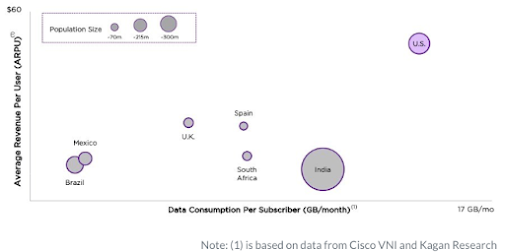It now is possible to suggest that a fundamental business problem in the internet era affects both mobile and fixed networks. In both cases, the fundamental issue for connectivity providers is the financial return from network upgrades, whether seen in fiber to the home or 5G and future mobile networks.
Simply, in a competitive market, capital intensity tends to increase as upgrades to fiber access or mobile networks happen. But revenue does not increase to match. Instead, the pattern is that bandwidth supply grows more exponentially, while customer revenue can grow only linearly, at low single digit rates.
Higher capital intensity with inelastic revenue growth is therefore the key strategic problem.
It is a bad scenario, when looked at in traditional financial terms. The capital investments, however, essentially are strategic. Many decades ago, a telco executive facing competition from cable operators concluded that the upside of FTTH was not “more revenue” but “we get to keep our business.”
That is not the sort of analysis a financial analyst would find appealing.
But that is essentially what upgrades to 5G (and future upgrades) mean. More capital-intensive networks must be deployed to preserve what already exists: the ability to serve customer demand in terms of capacity (gigabytes used) and speed.
Telco upgrades to FTTH essentially represent the same sort of value: consumer and business account market share is protected from predation and loss to competitors. Spending more money to protect what one already has might not sound like a victory.
But it is far better than the alternative: continued share loss to competitors and ultimately, a non-viable business model. Sustainability and survival, in other words, is the upside. Revenue growth is nice, but survival is essential.
The basic issue is that end user demand for data increases almost linearly with time, while the amount of money paid to use networks increases only marginally, if at all, in some cases.
GlobalData, for example, expects U.S. 5G services will generate average revenue per user of $45.56 during 2022, with 4G generating ARPU of $26.41.
But matters could change. GlobalData expects that U.S. 5G ARPU will be more than double 4G ARPU in 2023. If that happens, it is almost certainly going to be driven by new use cases and revenue streams such as edge computing, network slicing or content services, we can speculate.
It is hard to imagine that much growth from consumer data plan price increases. Up to this point, much of the ARPU increase has been driven by customer upgrades to unlimited usage plans. The obvious problem there is that this is basically a one-time source of revenue lift.
By definition, once a customer plan is upgraded to unlimited usage, usage cannot, itself, drive incremental revenue growth. Price increases largely reflecting inflation adjustments will happen, but beyond that, data usage will not drive ARPU growth.

source: GlobalData
Mobile operator executives are right to worry about the financial return from 5G. Those networks are more expensive than 4G. But the alternative is going out of business.
Traditional financial analysis still matters. Firms will be punished if higher capex results in either the same or lower revenue. But the fundamental problem remains: higher capex now is required to preserve the ability to compete for business.
New revenue and use cases ultimately will be found. But those revenues might only compensate for declines in legacy parts of the business. It is an unappetizing prospect, but a realistic possibility.
FTTH and 5G succeed if service providers continue to operate and continue to generate profits. For the most part, single-digit revenue increases might be the best outcome. That will not be easy to defend if capex increases more than that. But that is the nature of a connectivity provider’s position in the internet era.
Bandwidth always must increase. Revenue will grow very slowly. The financial returns from increased capex will be paltry. But firm extinction is the inevitable result, if the investments are not made.
“You get to stay in business,” like it or not, is the strategic driver of capex. “Higher revenue” is nice if it can be obtained. But it is largely adjustments in other parts of the business model that will help drive such results.
It is fine to question the 5G or FTTH payback model, and to take other steps to support the business model when those investments are made. But traditional investment criteria will be hard to satisfy, without other adjustments of the payback model.

